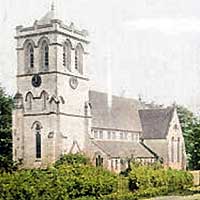Funeral services and burials in Victorian and Edwardian England

The funeral services of ordinary people were in two parts in Victorian and Edwardian England: the first part indoors and the second at the graveside. This page describes what happened in each part with special reference to the work of the grave diggers, the eulogy, the flowers and the implications of bad weather.
____
Extracted from the memoirs of the webmaster's mother (1906-2002) and edited by the webmaster with further research
Why funerals not cremation
Funeral services while I was growing up in the early 1900s had changed little since Victorian times. Although cremation was formally legalised in the UK with the passing of the Cremation Act of 1902, it did not catch on quickly with ordinary people, particularly with the older ones who were most likely to die first.
These old-style two-part funerals were depressing affairs.
The first part of the funeral service - indoors
The first part of the funeral service was inside a church. I only saw them in Church of England or non-conformist churches which had their own graveyards, but there must have been communities with other arrangement which used their own meeting houses and public cemeteries.
The funeral services that I knew were quite short. Apart from the sombre funeral clothes that everyone wore, including the widows weeds worn by the women of the close family, and denominational and cultural differences, the service could easily be like one today. What would not normally be like a funeral service today, was the second part which was outside at the graveside.
The second part of the funeral service - at the graveside
For the second and major part of the funeral service, everyone went outside to the graveside. There they all stood - whatever the weather!

The graveside. Screen-shot from an old film.
The grave diggers would already have dug the hole for the coffin and they would be waiting there, ready to lower the coffin into the grave. They did this using two or three long braids under the coffin, a gravedigger at each side.
Once the coffin was in place, but not yet covered up, the minister would conduct the second part of the service. At this point came the eulogy when someone who had been asked in advance would make a short speech about the life of the deceased, and anyone else who wanted to could also say a few words.
When the minister came to the part about 'From dust to dust - from ashes to ashes', he would take a handful of earth and sprinkle it on the coffin. Anyone who wanted to, then took their own handful of earth and sprinkled it on the coffin.
It was very emotional.
Most people dispersed fairly quickly and informally after the second part of the service, and close family and friends went on to the wake.
Then the gravediggers would fill in the grave, place the flowers on it and mark it with the name of the deceased using something temporary. The final gravestone would not be put on for several months or more to allow the soil to settle.
Implications of bad weather at the graveside
Whatever the weather, men were expected to stand bareheaded at the graveside throughout the second part of the service - and they often caught cold because so many deaths were in the depths of winter. Not infrequently the older men died as a result. There was a saying that one death heralded another.
So, with respect, people of my generation say thank you for cremation, although we did hear some gruesome tales when cremation first started to become fashionable - such as that when the coffin slid through the curtains and you saw the flames leap up. I suppose such exaggerated talk always comes with anything new.
| sources | webmaster | contact |
Text and images are copyright
If you can add anything to this page or provide a photo, please contact me.



